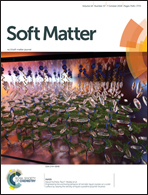Tuning of volume phase transition for poly(N-isopropylacrylamide) ionogels by copolymerization with solvatophilic monomers
Abstract
Ionogels are crosslinked polymer networks that swell in ionic liquids (ILs) and exhibit high conductivity and chemical stability. Combined with a representative thermally responsive polymer, poly(N-isopropylacrylamide) (PNIPAm), previously studied ionogels fulfilled the requirements for smart responsive materials, but their transition temperature in hydrophobic ILs exceeded that which could be used for practical applications. In this study, we prepared transition temperature tunable ionogels via copolymerization of NIPAm with solvatophilic N,N′-diethylacrylamide (NDEAm). The hydrophobic diethyl moiety in NDEAm promoted ionogel solvatophilicity toward the IL, resulting in a larger swelling ratio, lower volume phase transition temperature, and narrower transition range with increase in NDEAm content in the prepared ionogels. Based on these fundamental observations, ionogels that exhibit a volume phase transition near room temperature were prepared. We also studied the swelling and deswelling kinetics of the prepared ionogels, revealing that the deswelling rate is much slower than swelling due to the formation of a dense skin layer on the ionogel surface.



 Please wait while we load your content...
Please wait while we load your content...